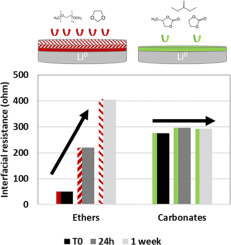Solid State Ionics ( IF 3.2 ) Pub Date : 2020-04-18 , DOI: 10.1016/j.ssi.2020.115321 Benjamin Mercier-Guyon , Benoit Chavillon , Eric Mayousse , Annaig Le Comte , Yvan Reynier , Céline Barchasz

|
Lithium metal electrodes are known for problematic formation of lithium dendrites and poor cyclability, especially in liquid-based electrolytes. Severe SEI formation along with lithium and electrolyte consumption are responsible for sudden failure of lithium metal cells, this phenomenon being more pronounced with highly loaded electrodes and deep stripping/plating cycles. In this paper, the goal was to compare the commonly used carbonate-based electrolytes with ether-based formulations, which are usually employed in lithium/sulfur systems, as well as to quantify the effect of frequently used additives on the behavior of lithium metal, using a relatively simple characterization methodology. In particular, the objective is to focus on the effect of electrolyte composition on the fading of lithium metal electrode, while preventing the use of contaminating high capacity positive electrodes such as layered oxide as well as sulfur cathodes. LiFePO4/Li and symmetric Li/Li cells were assembled to investigate the behavior of lithium metal electrode in different electrolyte media, while high loading positive electrodes were employed to study the lithium electrode into a high energy density cell design.
中文翻译:

电解质成分对高能锂金属电池的影响
锂金属电极因锂枝晶的形成问题和可循环性差而著称,特别是在基于液体的电解质中。严重的SEI形成以及锂和电解质的消耗是锂金属电池突然失效的原因,这种现象在高负载电极和较深的剥离/镀覆循环中更加明显。在本文中,我们的目标是将锂/硫系统中常用的碳酸盐基电解质与醚基配方进行比较,并量化常用添加剂对锂金属性能的影响,使用相对简单的表征方法。具体而言,目标是集中于电解质成分对锂金属电极褪色的影响,同时避免使用污染高容量正电极(例如层状氧化物)和硫阴极。磷酸铁锂组装了4 / Li和对称Li / Li电池以研究锂金属电极在不同电解质介质中的行为,同时采用高负载正电极将锂电极研究为高能量密度电池设计。

























 京公网安备 11010802027423号
京公网安备 11010802027423号